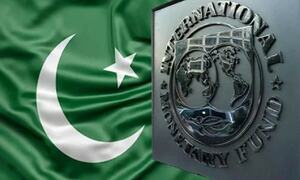The snapshot of money expansion of the past six years shown on the first page of the latest Monetary Policy Statement clearly depicts how the pattern changed, once the government started borrowing heavily from banking system in FY08. The tale is dismal for private sector credit growth thereafter - crowding out is visible while note printing is fuelling inflation.
This inefficient allocation of monetary resources is impeding tight monetary policy objective to narrow the gap of aggregate demand and supply. "The aggregate demand and supply gap is still large enough to push inflation further. Surging international food and commodity prices are also playing a role in intensifying expectations of rising domestic inflation", the MPS warns.
The SBP has revised its inflation forecast to 15-16 percent for FY11 and expects it to remain in double digit in FY12. This probably rules out any monetary easing going forward, given the status quo in January review.
"To bring inflation under control, the critical measures would be fiscal consolidation and reduction in fiscal deficit and government borrowings from the SBP. These measures would support SBP's efforts to contain monetary expansion and thus ease aggregate demand pressures", the MPS asserted.
In the meanwhile SBP governor, Shahid Kardar banks upon the government's promise to keep its borrowing from the central bank at September 2010 levels, as he is optimist that political parties will reach a consensus on the economic agenda of putting the fiscal house in order.
This along with the only silver lining in macroeconomic fundamentals ie better BoP position was enough for monetary policy committee to decide for keeping discount rate at 14 percent after three consecutive rise of 50 bps each.
However, the MPS warned that high inflation is eroding exports' competiveness through real appreciation of rupee. "If the difference between domestic inflation and that of the trading partners is not brought down, the pressure on exchange rate to depreciate could increase. In turn, this could make imports more expensive, causing domestic inflation to rise further", the SBP said.
Reportedly the votes of monetary policy committee were split between rate hike and status quo; this fact when seen in the light of low probability of government's success to meet Kardar's expectations, the chances of hike in March are high.
The NDA-to-NFA ratio, closely watched by monetary managers, have improved a bit after the CSF inflows of $743 million were used for retiring SBP's borrowing; for 2QFY11 the NFA increased by Rs 85 billion (1Q: Rs 42bn) while the government's budgetary borrowing was slashed by Rs 28 billion (1Q increase: Rs 121bn). Plus, the break-up of NDA is encouraging as well - the private sector credit increased by Rs 211 billion versus a decline of Rs 48 billion in previous quarter.
Despite the dampening impact of higher interest rates seasonal demand from manufacturing sector increased; 86 percent of credit demand in the last quarter was for working capital needs with more than half of demand generated by the textile sector on account of doubling cotton prices.
"On the other hand, credit for fixed investment continues to show a declining trend. The fundamental reason for this discouraging behaviour remains severe electricity and gas shortages and deteriorating law and order conditions. Without addressing these issues it would be difficult to revive domestic investment and sustainable economic growth", the MPS rightly pointed out.
It also stressed upon Finance Ministry to be realistic in its borrowing target from market. The market participation pattern in T-Bills auctions is clearly depicting higher inflationary and interest rates expectations. "On average, more than 60 percent of the bids in the recent auctions are for 3-month T-bills. Whereas, bids for 12-month T-bill have fallen below 10 percent", SBP added.
"Even if government borrowing from SBP is contained, the overall demand for money may not subside during H2-FY11 given incremental government borrowings from scheduled banks. The required reduction in the demand for money would require a reduction in the fiscal deficit - the source of continued government borrowings from scheduled banks", MPS added.
In other words, it's a catch-22 situation, with all boiling down to the political will for economic reforms. And that means, considering the current fiscal quagmire and the political history, the SBP may revert to tightening soon.
MONEY AGGREGATES:
The government retired Rs 49 billion from the central bank and scheduled banks to reduce its year-to-date borrowing to Rs 298 billion by January 15. With the governor's speech on government assurance to freeze its borrowing from central bank at current levels, its reliance on scheduled banks is going to be more in coming weeks.
Private sector credit surged by another Rs 11 billion to make the year-to-date credit to surge to Rs 134 billion. However, with slow down in seasonal working capital need amid absence of long term investment corporate may remain sidelined for coming few weeks.
With slash in government borrowing and slight increase in currency-in-circulation demand and time deposits fell by Rs 48 billion for the week ending January 15. The overall money supply declined by 0.73 percent or Rs 42 billion to reduce the year to date increase at Rs 453 billion.
===============================================================
KEY MONETARY AGGREGATES AS ON JAN 15
===============================================================
Rs (mn)
15-Jan 8-Jan Change
===============================================================
Currency in Circulation 273,555 267,579 5,976
Total Demand & Time Deposits 178,975 227,179 (48,204)
Broad Money (M2) 453,901 496,089 (42,188)
NFA 126,930 129,443 (2,513)
NDA 326,970 366,646 (39,676)
Net Government Borrowing 298,208 347,312 (49,104)
Borrowing for budgetary support 355,182 400,834 (45,652)
from SBP 133,007 153,878 (20,871)
from scheduled banks 222,175 246,956 (24,781)
Commodity operation (59,554) (56,110) (3,444)
Credit to non-govt sector 154,506 145,265 9,241
to private sector 134,014 122,827 11,187
to PSEs 19,676 21,622 (1,946)
---------------------------------------------------------------
Source: SBP
===============================================================
(Feedback at [email protected])






















Comments
Comments are closed.